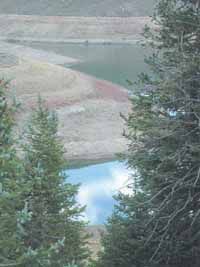| The banks of Electric Lake show the significant amount of water loss the storage facility has suffered in 2002. The water loss has Utah Power officials concerned because the lake serves as the backup cooling supply for the Huntington plant. Last year, underground workers at Skyline encountered a water pocket while drilling into the wall of the coal mine. The water quickly filled the section and continues to drain into the mine. The company’s concern is that the water may possibly be coming from Electric Lake. Therefore, an investigation by Utah Power will ensue to determine where the water from Electric Lake is going. |
A year has passed since workers at Skyline mine located near Scofield hit a water pocket. As a result, water started pouring into the coal mine.
At the time, workers began setting pumps into the water-filled section and clearing as much of the liquid as possible out of the area in order to proceed with mining efforts.
Since then, conditions have changed and several speculations have been formed regarding where the water is coming from.
The presence of water in a coal mine is not a new occurrence. In fact, the Skyline coal production operation is notorious for being a wet mine.
However, the amount of water being released into the section because of the pocket is above normal conditions for the particular coal mine.
Although production has resumed since the incident occurred last August, mine workers continue to pump water out of the flooded area.
According to Skyline’s parent company Arch Coal, the coal mine continues to pump an estimated 10 million gallons of water per day.
The water being pumped out of the mine is being released into Eccles Creek and eventually being released into Scofield Reservoir.
Soon after hitting the pocket at the mine, an investigation was launched by Arch Coal to determine the origin of the water.
The results of the initial tests suggested that the water was coming from a new source, one which was thought to have had no exposure to the atmosphere.
The tests conducted by the coal company focused on the presence of the chemical isotope tritium in the water.
Tritium is produced by hydrogen bomb tests and shows up in all surface water on the planet.
The preliminary tests at Skyline revealed little presence of tritium, thus leading officials to believe that the water originates from an underground source.
Since the initial testing was completed, little speculation has been made about the origin of the water. At least, that was the situation until recently.
Utah Power officials recently became concerned that the water being drained into the Skyline mine may be coming from Electric Lake. The lake is owned by the power company.
According to Utah Power spokesman Dave Eskelsen, the lake has been losing approximately 600 acre-feet of water per month for the past several months.
An acre-foot equals about 326,000 gallons and is equivalent to the amount of water an average family uses in a year.
Because the storage level at Electric Lake continues to drop at such a rapid rate, Utah Power plans to launch an investigation to determine whether the water is being lost into the Skyline coal mine.
Electric Lake is an important commodity to the Huntington power plant because it provides the backup supply of cooling water for the electricity generating facility.
The primary source of water in the lake comes from the Huntington Creek. Due to the ongoing drought conditions, it is extremely difficult to secure water supplies.
Because the lake continues to significant amounts of liquid on a monthly basis, Utah Power plans to reduce the flow into the creek in order to conserve water.
The power company operates the reservoir under a special use permit with the United States Forest Service, pointed out the officials.
The permit contains a provision which allows Utah Power to reduce the water flow in emergency situations.
While the investigation ensues to determine the cause of the water loss, the power company plans to reduce outflows to six cubic feet per second – or half the 12 cubic feet per second called for in the original permit.
The water flow reduction will not only affect the water levels of Electric Lake, but it will also impact the trout in Huntington Creek.
The reduced water flows could affect the amount of gravel on the stream bottom, which in turn would decrease spawning habitats.
Because there is so many factors at stake, the investigation into the matter is expected to move at an accelerated pace.
No testing is currently being conducted by Arch Coal at the Skyline mine site.
However, according to company spokesman Deck Slone, Arch Coal is aiding Utah Power’s investigation by providing information.
“This investigation is a cooperative effort. Our company is providing Utah Power with the information which we have in order to aide their studies. Our engineering staff continues to share their data about the carbon dating tests which were ran earlier this year. Arch Coal plans to work hand-in-hand with the power company during this investigation,” explained Slone.
Although water continues to enter the mine, production has resumed at Skyline. The coal company produces three to four million tons of coal per year. Despite water problems, this average is expected to be met again this year.
Despite the coal mine and the power plant being located near one another, the mine does not provide coal to the Huntington Plant like many Carbon County residents assume. In fact, the coal produced at Skyline is shipped to various locations across the country including Nevada Power. The primary coal source for Huntington Plant comes from Utah Power owned Deer Creek Mine which is located near the power plant.
As the studies continue, one thing remains the same. Skyline Mine has too much water while Electric Lake does not have enough.

